


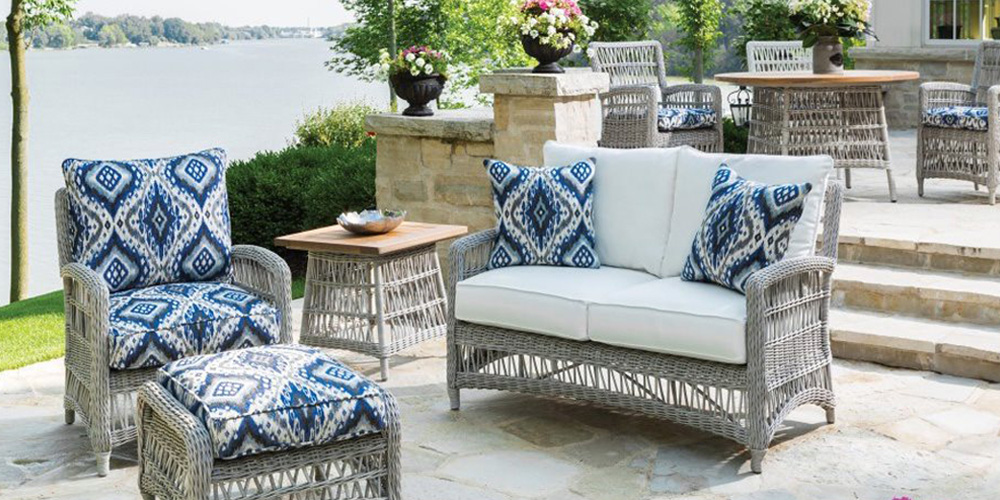
The type of material you decide to use for your patio plays a huge role in your set’s functionality, durability, and longevity. From chaise lounges to patio dining tables, outdoor furniture is designed to withstand the harsh elements of the outdoors. LuxeDecor takes a look at the most common outdoor materials used in outdoor furniture to guide you through the options available to create your personal outdoor oasis.

Good to Know: Also known as tubular or hollow aluminum, aluminum outdoor furniture refers to aluminum that has gone through the process of extrusion. Extrusion simply means a piece of metal forced through a machine that shapes it into a hollow round or square frame. Aluminum is a natural conductor of heat, so look for a powder-coating finish that makes it UV-resistant and rust-proof. (Powder coating is a technique used to paint metals where polyester or epoxy powder is fused with the surface to create a protective barrier). Aluminum furniture is available in a number of different styles and colors. Aluminum outdoor furniture has different benefits than cast aluminum.
Benefits: Extremely lightweight, durable, resistant to corrosion and change in temperatures, low maintenance, easily portable, affordable
Care: Wash with soapy water to remove dirt and debris. Car wax and mineral oil can be used to protect the surface, but not necessary.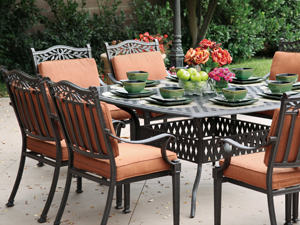
Good to Know: Unlike traditional aluminum outdoor furniture which is hollow, cast aluminum outdoor furniture is constructed from solid aluminum throughout. Cast aluminum is considerably more expensive and labor-intensive to construct because metal is cast from molds where molten metal is poured to form intricately detailed forms. Because cast aluminum is solid throughout, it is heavier than traditional aluminum furniture. It is typically characterized by traditional design elements and classic, ornate styles.
Benefits: Extremely durable (at least 15-20 years of use), stable (will not move in windy conditions), rust resistant (great for residents in coastal cities or regions with high humidity)
Care: Wash with soapy water to remove dirt and debris. Rinse off with regular water.

Good to Know: Before aluminum and cast aluminum was developed as a building material, wrought iron was the go-to material used for building applications and construction. Wrought iron is comprised mainly from low carbon iron mixed with fibrous slag inclusions. While wrought iron is no longer produced for commercial use, some wrought iron furniture is a combination of cast iron, “machine wrought iron”, and low carbon steel that is handcrafted into into frames with intricate detailing. Select manufacturers, such as Woodard, continue to manufacture hand wrought iron outdoor furniture. Wrought iron is prone to rusting, however modern powder coating finishes help protect wrought iron from corrosion.
Benefits: Extremely strong, sturdy, durable
Care: Clean with a damp cloth with equal parts water and mild dishwashing detergent. Apply a rust protector and use paint to touch up cracks when necessary.

Good to Know: Stainless and galvanized steel is heavier than aluminum, but considerably lighter the iron. Steel sets are considered more comfortable than iron sets. Because steel is a conductor of heat, steel outdoor furniture can become hot to the touch. Consider using cushions to prevent discomfort. Look for stainless steel outdoor furniture sets which are rust-proof.
Benefits: Sturdy, durable
Care: Apply a protective finish to protect non-stainless steel outdoor sets to prevent rust and corrosion. Wash with soapy water to remove dirt and debris. Rinse with water.
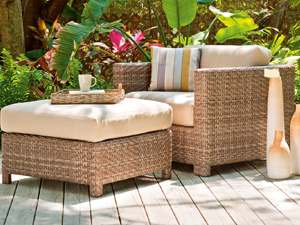
Good to Know: Wicker is a broad term used to describe anything from natural fibers, including grasses and woods. Though natural wicker is typically not suitable for outdoor use because the material is biodegradable, the advancement of natural looking synthetics and vinyl reproductions bring the “wicker look” with added resilience and strength. Rattan boasts a strong core with vertical grains, which makes it naturally durable, yet flexible. Synthetic wicker (also referred to as all-weather wicker) is made from resin with dyes mixed in to ensure the color runs all the way through the material. The synthetic material is cut into thin strips, woven, and wrapped over a metal frame.
Benefits: Lightweight, flexible, comfortable, available in a range of colors
Care: Clean with a damp cloth with equal parts water and mild dishwashing detergent. Rinse with regular water.
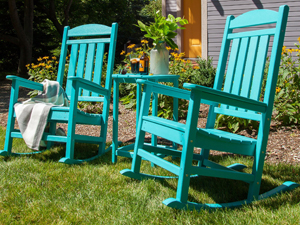
Good to Know: Marine grade polymer is a specific form of plastic that’s often similar in density and performance to natural wood, without the disadvantages of natural wood such as splintering. Recycled plastic products are very similar to MGP products, but have a slightly different feel. Both recycled plastic and MGP are made from high-density polyethylene, and can be made to resemble many types of materials including natural materials like wicker and wood.
Benefits: Extremely durable, weather-, fade-, and rust-resistant, low maintenance, lightweight
Care: Use cleaners that prevent mildew. Rinse with regular water.

Good to Know: The most traditional choice for outdoor furniture is wood, and includes many varieties such as teak, cedar, oak, and eucalyptus (among many others). Wood varieties such as eucalyptus and acacia are sustainably resourced, and woods like cedar and pine are softwoods. Look for pressure-treated pine for high-quality. Woods will age naturally when exposed to outdoor elements when left unsealed or are not refinished. Solid wood furniture is comprised of multiple pieces of wood attached to each other. Wood can be carved and shaped endlessly into different designs, and can prove more expensive than metal outdoor furniture.
Benefits: Non-heat-absorbing, strong, sturdy, long-lasting (if well cared for), natural attractive apperance
Care: Wood furniture requires more maintenance than metal outdoor furniture. Wood furniture may require sealants and preservatives to make it water-repellant, insect-resistant, and mold-resistant. However, wood furniture is suitable for outdoor use. Wood outdoor furniture will age naturally and beautifully with a natural patina if not preserved with sealers. Use oil and a brightener to maintain its original appearance if your wood set is unpainted. If your wood outdoor furniture is painted, be mindful to use paint with UV filters to prevent fainting. Check for splinters with wood outfurniture that is well-worn, and refinish.
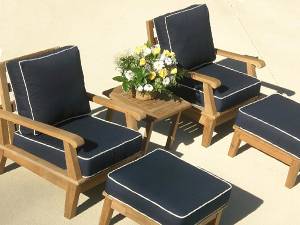
Good to Know: Teak is a dense-grained tropical hardwood that has an abundance of natural oil and rubber in its core. These protective oils give teak its natural weather-resistant and insect-repellant properties. Teak is an extremely durable wood that naturally requires little maintenance or care. Outdoor teak furniture is typically sold in one of two conditions: in its natural form, which carries a warm, golden-honey patina that is treated with teak oil. When left untreated, teak will age to a silver-gray tone, which some people prefer. Weather-resistant teak outdoor furniture is ideal for year-round use. Its high oil content levels contribute to its long-lasting nature. A well-made teak outdoor set will feature quality wood craftsmanship such as dowel joints and mortise-and-tenon joinery. If hardware is used instead, check that it is made from stainless steal or brass to prevent rust and corrosion which will wear out your set faster. Also check the thickness of the lumber used. Teak outdoor table legs should measure at least 1.5 inches on all sides (unless the pieces are sculpted). Teak outdoor furniture is typically more expensive than other materials.
Benefits: Naturally mold-, rot-, and insect-resistant, extremely durable, strong, natural attractive appearance
Care: Regular maintenance will help prevent discoloration on both treated and untreated teak wood:



